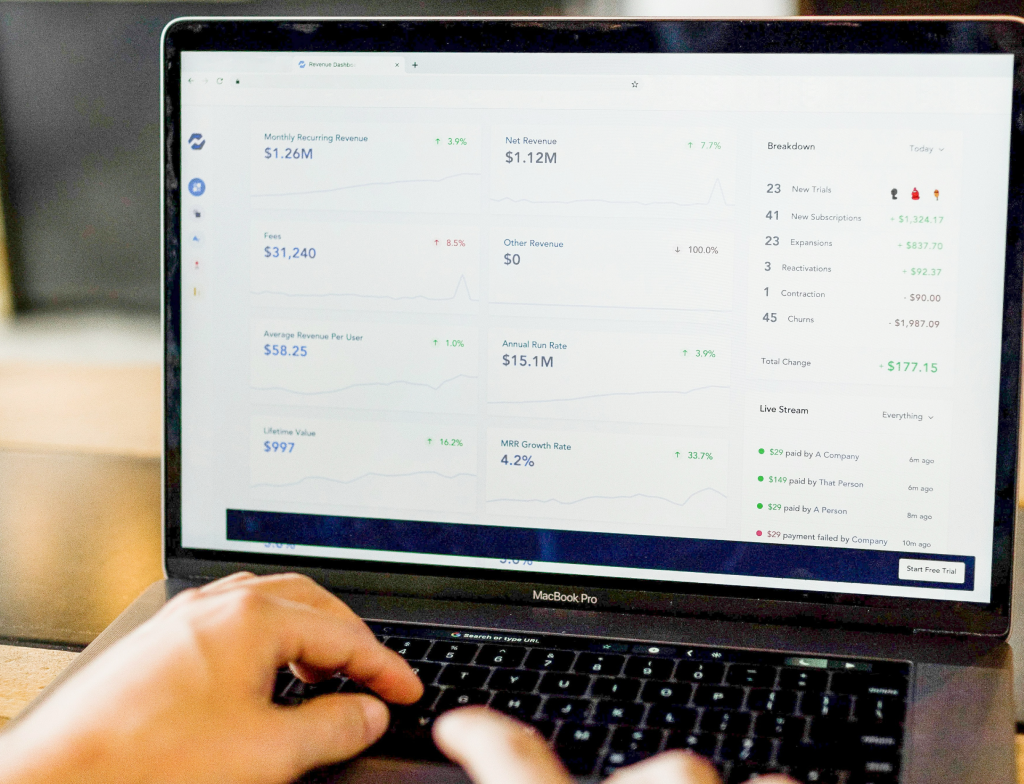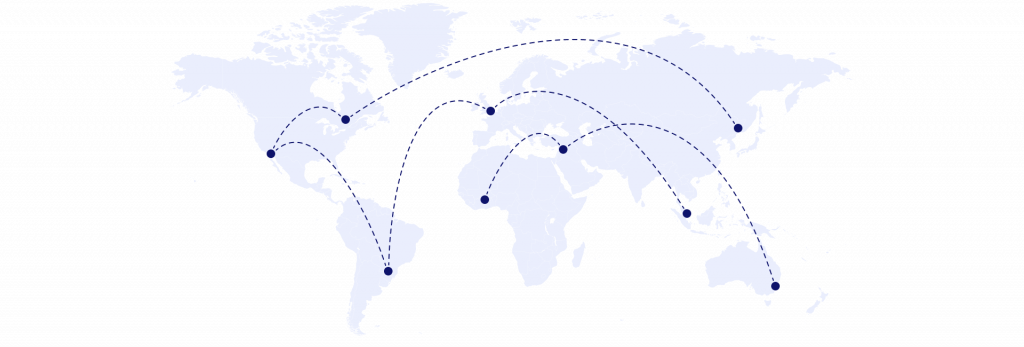What is a multi-currency account? And how does it work?
Last update: 15 Oct 2025
Pay, collect and hold funds in multiple currencies with a multi-currency account. Discover the smart way to manage cross-border payments.
Key takeaways:
- A multi-currency account allows businesses to transact, hold and manage multiple currencies
- Hold funds to pay suppliers or withdraw them to your bank account at any time
- You can get a local account number and banking details for each currency without needing a local address
- WorldFirst allows Australian businesses to open multi-currency accounts

Imagine you have a business in Australia with a product supplier in China and customers in Australia, China and Europe.
When you receive payments from customers in EUR or RMB into your standard bank account, these funds are automatically converted into the base currency of your bank account – AUD. The conversion rate offered by banks is usually high, and conversions usually come with extra transaction fees.
When you need to pay suppliers in China, you then need to convert the received funds back from AUD to RMB. The double conversion, high exchange rates, and transaction fees significantly impact your profit margins and business’s bottom line.
This is where multi-currency accounts can make a big difference. In this article, we’ll cover everything you need to know about multi-currency accounts and highlight the best options available in Australia. Let’s take a look.
Table of Contents
What is a multi-currency account?
A multi-currency account allows businesses to transact, hold and manage multiple currencies. Unlike traditional bank accounts, which only allow you to hold a single currency, a multi-currency account lets you hold multiple currencies simultaneously. You can get a local account number and banking details for each currency without needing a local address.
The number of currencies your account supports will depend on your service provider. While some multi-currency or foreign currency accounts are offered by leading banks, others are offered by global payment service providers like WorldFirst.
How does a multi-currency account work?
A multi-currency account works similarly to a normal bank account, but instead of being limited to just one currency, you can send, receive and hold multiple currencies.
When you receive payment in a foreign currency, you can either withdraw those funds back to your bank account or hold the funds to make supplier payments.
Let’s say you have an online e-commerce business based in Australia with a supplier and shipping partner in China and customers in the US, Europe and China.
Here’s how a multi-currency account can streamline cross-border payments for your business:
- To pay your suppliers and shipping partners in China, you must convert AUD to CNH. With a multi-currency account, you can convert funds when exchange rates are favourable and then use those to pay suppliers and shipping agents.
- Because you’re using a local CNH account to pay, your suppliers and shipping partners get paid like they would from a local Chinese bank account. This means that it takes less time for the payments to clear.
- When you receive customer payments, the funds will go into their respective local currency accounts without currency conversion. You can withdraw funds into your bank or hold them to make further payments.
Pros and cons of a multi-currency account
Pros
- Easy transactions in multiple currencies: You can manage several currencies through a single account. It’s also possible to send and receive money directly in these currencies. Some providers may even offer multi-currency cards to make business expenses easier
- Low currency exchange rates: Multi-currency accounts usually offer a lower conversion rate than standard bank accounts. You can also hold the currency in your account and exchange it when the exchange rates are favourable.
- Send and receive payments like a local: Whether you have suppliers in China or customers in Europe, you can manage transactions like a local without any transfer delays or banking complications.
- Foreign exchange risk management: By locking currency exchange rates with forward contracts, businesses can protect themselves from sudden shifts in exchange rates.
- Higher profit margins: When you don’t have to pay unnecessary conversion costs and transaction fees, it directly leads to cost savings and increased profit margins.
Cons
- Limited provider options: Not all banks or fintechs offer multi-currency accounts, and options may be limited depending on your region or business type.
- Limited currencies: While most multi-currency account providers offer the major currencies, you may struggle to find one that supports all the currencies you require. For instance, only a handful of providers support Chinese yuan accounts.
- Monthly or maintenance fees: Some providers may charge ongoing fees, which can add up over time if you’re not actively using the account.
- Minimum balance or deposit requirements: Some providers ask for a minimum opening deposit or ongoing balance to keep the account active.
What does it cost to setup a multi-currency account?
The fees for a multi-currency account will depend on the service provider you partner with. Before signing up for a new account, the first step should be to check the pricing. Here are the costs that you should look for when setting up a multi-currency account:
- Account set up fees: There can be fees for creating and setting up a new account.
- Monthly/ annual fees: These are regular account maintenance fees.
- Transaction fees: It includes fees for sending and receiving payments. Ideally, you should look for a multi-currency account that allows you to receive payments for free without any extra charges.
- Conversion fees: These include the usual conversion rate for different currencies.
- Fund holding fees: Some multi-currency account providers may also charge you for holding large sums of money in your account.
- Multi-currency card fees: You may even be charged a separate fee for getting multi-currency cards for you and your team.
Is a multi-currency account the same as a foreign currency account?
A multi-currency account gives you access to multiple local and offshore currency accounts.
A foreign currency account usually only supports one foreign currency. So, if you need to manage USD, HKD and NZD, you’ll get a separate local currency account for each. With a multi-currency account, on the other hand, you can manage all these currencies with one login.
What are the main multi-currency account features?
Here are the main multi-currency account features:
Hold and manage multiple currencies in one account
A multi-currency account allows you to hold and manage currencies – like USD, EUR, GBP and HKD – within a single account. This makes it easy to organise your cash flow by currency, reconcile international invoices and simplify financial reporting. You can use the funds in each currency to pay suppliers, cover overseas expenses or withdraw profits without triggering unnecessary currency conversions. It’s an efficient way to centralise global business operations while keeping control over each market’s financial activity.
Send and receive international payments
Multi-currency accounts make cross-border transactions seamless. You can send and receive payments globally in your supplier’s or customer’s preferred currency – whether it’s paying a factory in China in CNH or accepting USD from a US-based customer.
You eliminate double conversions, reduce transaction costs and improve payment speed (depending on the provider). By transacting in the local currency, you also build trust with international partners and avoid complications from currency mismatches. For businesses working with global teams, vendors or clients, this ensures smoother, more cost-effective international money movement.
Choose when to convert currencies
Instead of converting funds immediately, you can wait until the exchange rates are more favourable. This helps you reduce the impact of exchange rate movements and gives you more control over your money. Having the ability to convert currencies at the right time can make a big difference to your profit margins, especially if you’re moving large amounts.
Instead of converting funds immediately upon receipt, a multi-currency account gives you the flexibility to hold funds and convert them when exchange rates are in your favour.
For even greater control, many providers also offer forward contracts and firm orders.
- A forward contract lets you lock in an exchange rate for a future date, helping you protect against currency movements. This is especially useful if you have upcoming payments or expected income in a foreign currency and want to manage your budget or have peace of mind.
- With a firm order, you can set a target exchange rate and your funds will be automatically converted when the market hits that rate. There’s no need to constantly monitor the markets yourself.
Access local currency account details
Most multi-currency account providers give you access to local bank account details complete with account number and bank code. You can use these account details to collect payments from marketplaces or directly from your customers.
For instance, you can sell on Amazon US from Australia by adding a local USD account number and routing code to your seller account. Amazon will pay you in USD, helping you avoid international transfer fees, speed up settlement times, and improve cash flow. You can hold the collected USD in your account and use it to pay US-based suppliers or marketing agencies without incurring unnecessary double conversions.
Lower fees and more transparency
Compared to traditional business transaction accounts, multi-currency accounts have more competitive foreign exchange rates and international transaction fees. However, you should watch out for monthly fees, additional hidden fees or high exchange rates. The best providers are upfront about their fees and let you see the total cost before making transfers.
Can I open a multi-currency account for my business in Australia?
Yes, Australian businesses can open a multi-currency account to manage transactions in various foreign currencies. This is particularly beneficial for businesses dealing with international customers and suppliers.
To open a multi-currency account in Australia, your business typically needs the following (The eligibility requirements for a multi-currency account will depend on the provider)
- An Australian Business Number (ABN) and/or an Australian Company Number (ACN).
- At least one eligible Australian Dollar account with any bank
- Identification documents of the owner or the main directors in the company
- Additional documents as specified by the provider
For foreign companies operating in Australia, registration with the Australian Securities and Investments Commission (ASIC) is usually required. Eligibility for other foreign entities may be assessed on a case-by-case basis.
The process to open a multi-currency account varies among providers as well.
- Traditional banks: Some banks may require you to complete an application form and visit a branch or consult with a relationship manager
- Online payment platforms: Most global payment platforms offer online applications, allowing you to open accounts in multiple currencies without needing to visit an office
What are the best multi-currency accounts in Australia?
Here’s a quick look at some of the top multi-currency accounts in Australia for businesses making frequent international payments:
WorldFirst
WorldFirst helps international businesses manage money globally. With the multi-currency World Account, you can open local receiving accounts in 15+ currencies, including USD, GBP, EUR, AUD, JPY, NZD, SGD, HKD, CNH and CAD without needing a local presence. You can also send international payments in over 100 currencies to more than 200+ countries and regions, safely, securely and at speed.
You can collect payments from 130+ e-commerce marketplaces and payment gateways like Amazon, eBay, Etsy, PayPal, and Stripe, with no fees for receiving funds or opening a new World Account. Enjoy fast, reliable payment processing and access to competitive exchange rates that help protect your profit margins (up to 0.6% for major currencies).
To simplify spending, WorldFirst offers the World Card – a business debit card powered by Mastercard that supports payments in over 150 currencies. When you spend in 15 major currencies, you pay zero foreign exchange fees (as long as you have sufficient funds in that currency). Businesses can request up to 20 cards at no additional cost, making it easy to empower global teams with controlled access to funds.
Pros of opening a foreign currency account with WorldFirst:
- Open local currency accounts in 15+ currencies
- Pay to China, USA, New Zealand, Europe and 210+ countries and regions in 100+ currencies
- Collect payments at zero costs from 130+ marketplaces and payment gateways
- Pay 1688 suppliers directly through your account
- Make instant and free transfers between World Accounts
- Keep more of what you make with competitive exchange rates
- Set up forward contracts or firm orders
- Decrease admin tasks with Xero and NetSuite integration
- No minimum balance required
WorldFirst fees
| WorldFirst | |
|---|---|
| Monthly fee | Zero |
| Opening a multi-currency account | Zero (15+ currencies) |
| Receiving funds | Zero |
| Sending payments to WorldFirst users | Free and instant payments |
| Sending payments to other accounts | |
| Holding funds in multiple currencies | Zero |
| Currency conversion | |
| Multi-currency card | ✅ Up to 20 virtual cards available at no additional cost |
| Forward contracts | ✅ |
| Integration with accounting tools | ✅ |
- Open 15+ local currency accounts and get paid like a local
- Pay suppliers, partners and staff worldwide in 100+ currencies
- Collect payments for free from 130+ marketplaces and payment gateways, including Amazon, Etsy, PayPal and Shopify
- Take control of spending with the World Card, a business expense card that saves you more with 1% cashback. Learn more
- Save with competitive exchange rates on currency conversions and transfers
- Lock in exchange rates for up to 24 months for cash flow certainty
Westpac foreign currency account
Westpac offers foreign currency accounts in 15 currencies (12 can be opened online).1 You can manage everything through online banking, from signing up to making transfers. But to open the account, you’ll first need an eligible Westpac AUD transaction account with online access. All the incurred fees will be deducted from the AUD account.
Pros
- Set up accounts in 12+ currencies
- Overdrafts available in some currencies
- No account opening or monthly fees
Cons
- Only existing customers can open the account online; new customers have to visit the branch
- Must link to a Westpac AUD account, which might have its own fees
- No multi-currency cards available
| Westpac foreign currency account fees2 | |
|---|---|
| Monthly fee | Zero |
| Multi-currency account | Zero (You need a linked Westpac AUD transaction account, which might have its own monthly or annual fees) |
| Receiving funds | AUD 12 for every payment |
| Sending payments | Zero to AUD 32, depending on the mode of transfers |
| Holding funds in multiple currencies | A deposit maintenance fee may apply, depending on the currency and amount |
| Currency conversion | A margin is added over the current market rates |
| Multi-currency card | ❌ |
| Forward contracts | ✅ |
| Integration with accounting tools | ✅ |
*Fees checked in August 2025
NAB
NAB supports 16 major currencies including USD, EUR and HKD, with no monthly account fee or minimum balance requirement.3 An overdraft facility is available to eligible businesses, but it’s subject to NAB’s terms. The interest rates charged on overdrawn amounts can vary depending on the currency.
Pros
- No account opening or monthly fees3
- No minimum balance3
- Overdrafts available3
Cons
- Account can only be opened at a NAB branch, not online3
- No eligibility information available on the bank’s website
- No multi-currency cards available
| NAB foreign currency account fees4 | |
|---|---|
| Monthly fee | Zero |
| Opening a multi-currency account | Zero |
| Receiving funds | AUD 15 |
| Sending payments | Zero to AUD 30 |
| Holding funds in multiple currencies | NAB may charge interest when funds exceed the threshold amount set for different currencies |
| Currency conversion | A margin is added over the current market rates |
| Multi-currency card | ❌ |
| Forward contracts | ✅ |
| Integration with accounting tools | ✅ |
*Fees checked in August 2025
Wise Business
Wise is a global account provider that allows businesses to open a multi-currency account with support for over 23 currencies at a one-time fee of AUD 65.6
Pros
- No monthly fees
- Provides local currency account details for 23 currencies6
- Mastercard-powered multi-currency debit cards are available5
Cons
- There’s a one-time fee of AUD 65 to get access to local currency details6
- Only three virtual cards can be issued at a time; physical cards have separate fee7
- All SWIFT payments attract a fee6
Check out the Wise business account review to learn more about the account.
| Wise Business account fees6 | |
|---|---|
| Monthly fee | Zero |
| Opening a multi-currency account | AUD 65 |
| Receiving funds | Zero for AUD, CAD, EUR, GBP, HUF, NZD, RON, SGD, TRY and USD (non-wire) SWIFT payments have a fixed fee, which depends on the currency |
| Sending payments | Fee starts at 0.63% (varies by currency) |
| Holding funds in multiple currencies | Free |
| Currency conversion | From 0.63% |
| Multi-currency card | ✅One physical card and up to three virtual cards available7 |
| Forward contracts | ❌ |
| Integration with accounting tools | ✅ |
*Fees checked in August 2025
Airwallex
Airwallex is another global payment provider that supports 20+ currencies, including USD, GBP, AUD, CNY and HKD.9 Plans start from AUD 29 per month with access to features like multi-currency cards and expense management.
Pros
- No setup fees
- Supports collecting payments through links and plugins
- Physical and virtual cards available
Cons
- Recurring monthly account fee starting at AUD 2910
- Some features like expense management are only available on higher plans10
- You only get assigned a dedicated account manager when you choose the AUD 999 per month plan10
Check out the Airwallex review to learn more about the account.
| Airwallex account fees10 | |
|---|---|
| Monthly account fee | AUD 29-999, depending on the plan (zero if you deposit at least AUD 5K per month or hold a minimum balance of AUD 10K) |
| Opening a multi-currency account | Zero |
| Receiving payments | Zero |
| Sending payments | Zero for domestic payments International payments attract a transfer and currency conversion fee SWIFT payments cost AUD 10-35 |
| Holding funds in multiple currencies | Airwallex does not specify any fee |
| Currency conversion | 0.5% for major currencies and 1% for other currencies |
| Multi-currency card | ✅Number of cards depends on the monthly plan.The starter plan of AUD 29 comes with 2 free employee cards and 10 company cards |
| Forward contracts | ❌ |
| Integration with accounting tools | ✅ |
*Fees checked in August 2025
Still unsure? Here’s a breakdown of the best business bank accounts in Australia and best multi-currency cards for global transactions
How to open a multi-currency account with WorldFirst
WorldFirst allows businesses to open multi-currency accounts for free. Within the World Account, you can open 15+ local currency accounts to collect payments from 130+ marketplaces and payment gateways. There are no fees for receiving funds and transfers between World Accounts are free and instant. Exchange rates are competitive, with full visibility before you convert.
Here are the steps to open local currency accounts with WorldFirst:
- Sign up for a WorldFirst account
- In your account dashboard, click ‘Create a new receiving account’
- Select the currency of your receiving account and click ‘Confirm’
Ready to get started? Open a World Account today.
Sources
- https://www.westpac.com.au/business-banking/bank-accounts/foreign-currency-account/
- https://www.westpac.com.au/content/dam/public/wbc/documents/pdf/cb/foreigncurrencyaccount.pdf
- https://www.nab.com.au/business/business-bank-accounts/specialised-accounts/nab-foreign-currency-account
- https://www.nab.com.au/important-information/business/banking-fees-charges#5-nab-foreign-currency-account
- https://wise.com/au/business/
- https://wise.com/au/pricing/business
- https://wise.com/help/articles/2935762/how-do-i-order-a-wise-card
- https://wise.com/us/blog/how-to-send-money-wise-to-wise
- https://www.airwallex.com/business-account/global-accounts
- https://www.airwallex.com/au/pricing
Disclaimer: The information contained is general only and largely our views. Before acting on the information you should consider whether it is appropriate for you, in light of your objectives, financial situation or needs. Although information has been obtained from and is based upon multiple sources the author believes to be reliable, we do not guarantee its accuracy and it may be incomplete or condensed. All opinions, estimates, mentioned products/services and referenced material constitute the author’s own judgement as of the date of the briefing and are subject to change without notice. WorldFirst shall not be responsible for any losses or damages arising from your reliance of such information.


Top no-fee bank accounts for businesses in Australia
Explore top no-fee business accounts in Australia for everyday banking, global payments and better control over cash flow.
Nov / 2025
The best business transaction accounts in Australia
Compare top business bank accounts in Australia and explore smarter global solutions to manage local and international payments.
Nov / 2025
Foreign transaction fee: Meaning and when it applies to you
Learn what foreign transaction fees are, when they apply and how to minimize them with effective strategies for your business.
Nov / 2025Choose a category below for more business, finance and foreign exchange support from WorldFirst.
- Almost 1,000,000 businesses have sent USD$300B around the world with WorldFirst and its partner brands since 2004
- Your money is safeguarded with leading financial institutions























































